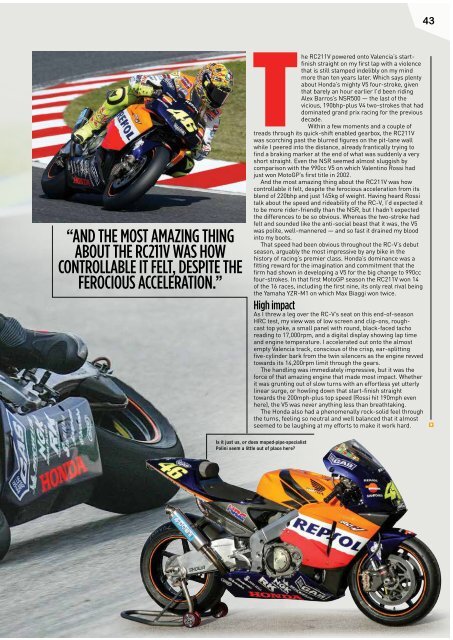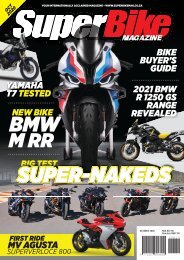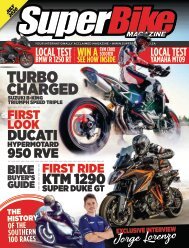SuperBike Magazine September 2020
Loads of content to keep any motorcycle enthusiast entertained!
Loads of content to keep any motorcycle enthusiast entertained!
Create successful ePaper yourself
Turn your PDF publications into a flip-book with our unique Google optimized e-Paper software.
43<br />
“AND THE MOST AMAZING THING<br />
ABOUT THE RC211V WAS HOW<br />
CONTROLLABLE IT FELT, DESPITE THE<br />
FEROCIOUS ACCELERATION.”<br />
The RC211V powered onto Valencia’s startfinish<br />
straight on my first lap with a violence<br />
that is still stamped indelibly on my mind<br />
more than ten years later. Which says plenty<br />
about Honda’s mighty V5 four-stroke, given<br />
that barely an hour earlier I’d been riding<br />
Alex Barros’s NSR500 — the last of the<br />
vicious, 190bhp-plus V4 two-strokes that had<br />
dominated grand prix racing for the previous<br />
decade.<br />
Within a few moments and a couple of<br />
treads through its quick-shift enabled gearbox, the RC211V<br />
was scorching past the blurred figures on the pit-lane wall<br />
while I peered into the distance, already frantically trying to<br />
find a braking marker at the end of what was suddenly a very<br />
short straight. Even the NSR seemed almost sluggish by<br />
comparison with the 990cc V5 on which Valentino Rossi had<br />
just won MotoGP’s first title in 2002.<br />
And the most amazing thing about the RC211V was how<br />
controllable it felt, despite the ferocious acceleration from its<br />
blend of 220bhp and just 145kg of weight. Having heard Rossi<br />
talk about the speed and rideability of the RC-V, I’d expected it<br />
to be more rider-friendly than the NSR, but I hadn’t expected<br />
the differences to be so obvious. Whereas the two-stroke had<br />
felt and sounded like the anti-social beast that it was, the V5<br />
was polite, well-mannered — and so fast it drained my blood<br />
into my boots.<br />
That speed had been obvious throughout the RC-V’s debut<br />
season, arguably the most impressive by any bike in the<br />
history of racing’s premier class. Honda’s dominance was a<br />
fitting reward for the imagination and commitment that the<br />
firm had shown in developing a V5 for the big change to 990cc<br />
four-strokes. In that first MotoGP season the RC211V won 14<br />
of the 16 races, including the first nine, its only real rival being<br />
the Yamaha YZR-M1 on which Max Biaggi won twice.<br />
High impact<br />
As I threw a leg over the RC-V’s seat on this end-of-season<br />
HRC test, my view was of low screen and clip-ons, roughcast<br />
top yoke, a small panel with round, black-faced tacho<br />
reading to 17,000rpm, and a digital display showing lap time<br />
and engine temperature. I accelerated out onto the almost<br />
empty Valencia track, conscious of the crisp, ear-splitting<br />
five-cylinder bark from the twin silencers as the engine revved<br />
towards its 14,200rpm limit through the gears.<br />
The handling was immediately impressive, but it was the<br />
force of that amazing engine that made most impact. Whether<br />
it was grunting out of slow turns with an effortless yet utterly<br />
linear surge, or howling down that start-finish straight<br />
towards the 200mph-plus top speed (Rossi hit 190mph even<br />
here), the V5 was never anything less than breathtaking.<br />
The Honda also had a phenomenally rock-solid feel through<br />
the turns, feeling so neutral and well balanced that it almost<br />
seemed to be laughing at my efforts to make it work hard.<br />
Is it just us, or does moped-pipe-specialist<br />
Polini seem a little out of place here?









